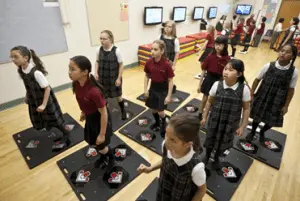
Teachers often have their curriculum planned for the entire year. This obviously changes due to unforeseen obstacles such as presentations, field trips, testing, and weather issues; but quality programs typically have a plan established at the beginning of the year. The next part of planning is figuring out which equipment is going to be used to accomplish the objectives of the unit/lesson. Exergames should be included in a curriculum only if they are going to make the lesson more efficient and/or more effective for the teacher and student. Multiple factors are involved in implementing exergames. Consider the following aspects of using exergames in the classroom:
1. Station Work
Many exergames provide a small number of students an opportunity to participate at a time. This is acceptable if the teacher plans other stations focusing on the same skill development to maximize participation with all children. Having a way to project the game on a wall or large screen is one way to incorporate more student involvement. However, if this is not available, multiple stations should be set up to increase repetition and activity levels for all students.
2. Rotations
As mentioned above, sometimes station work is the most effective way to include exergames in a lesson. Some exergames can take 3-4 minutes to complete the game while others can take much longer. It is common for children to get in the middle of these games and be reluctant to simply “rotate” when the whistle is blown. Understandable. Children like to finish what they have started and they also prefer not to pick up in the middle of another student’s game play. Teachers certainly need to keep this in mind when dealing with time constraints if exergames are involved.
3. Specific Feedback
Quality programs focus on providing feedback to students that is directly related to the stated objectives of the lesson. Exergames are fun and have a component of a “game” that tends to lead to more general feedback related to the score of the game or the level of the game accomplished. Although it is exciting to see the students involved and improving in the game, teachers must remember that the reason these games are being used is to improve skill levels. It is the teacher’s job to provide the more specific feedback related to the objectives of the lesson.
4. Technology Troubles
Let’s face it, technology is going to breakdown. There are many troubleshooting concepts to consider before letting dust collect on a “broken” game. Common issues are as simple as the game being on the wrong channel, unplugged, or batteries needing to be changed. The plug and play concept of many exergames may seem complicated but at the end of the day the problem may not be anything serious. Often, the students are able to figure out the issues themselves. It is important that teachers are familiar with the games they are implementing and are capable of working through the more simple problems. Teachers should also make sure they have the service number related to the game and feel comfortable working through other troubleshooting issues with the manufacturer.
5. Practicality
Quality teachers do a good job of connecting the lesson in school to a home environment. This is extremely important for children to understand how they can successfully use exergames at home. Discuss the use of technology-driven games as a great indoor activity and develop a positive correlation to video games and physical activity. This is important especially if children are not allowed to be outside for a variety of reasons. Educate parents on purchasing active games over sedentary games as a gift for various occasions (Christmas, birthdays, rewards, etc.). This is another way to support the desire to play games but in a healthier manner.
Exergames can be a positive addition to a physical education curriculum but there are many aspects teachers must consider. When the teacher is comfortable with the five points discussed above, using exergaming as a fun, effective tool in the curriculum can be a successful equipment choice for both the teacher and the students.




